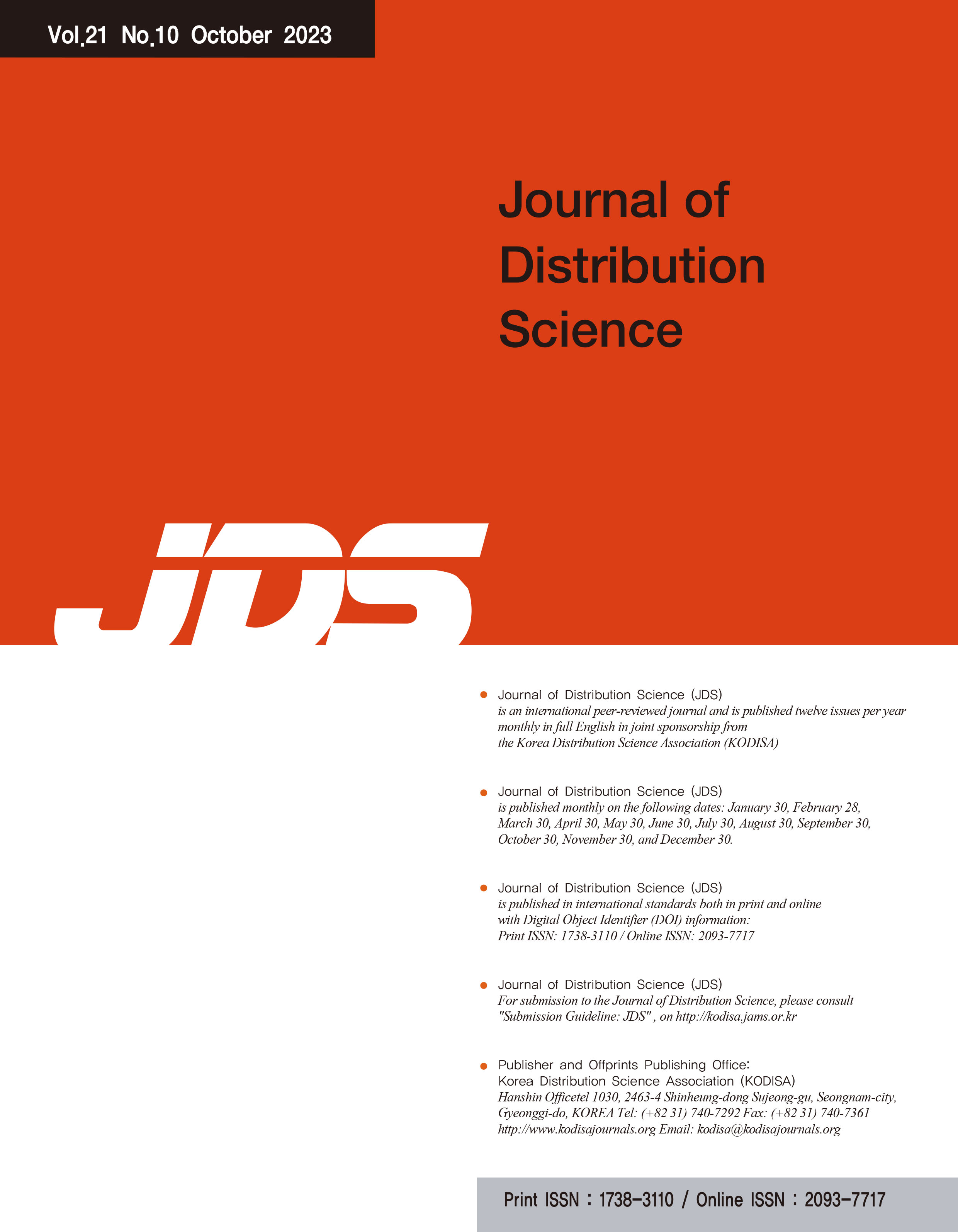 ISSN : 1738-3110
ISSN : 1738-3110
Influence of Global Competitive Capability on Global Performance of Distribution Industry in South Korea
KIM, Byoung-Goo
Abstract
Purpose: Purpose of this study is to empirically analyze influence of global competitive capability on global performance of distribution industry in South Korea. Also based on the empirical results, give managerial implication to distribution industry and contribute to academies of management. Research design, data and methodology: This study focuses on relationship analysis between global competitive capability and global performance. This study measured global competitive capability with three concepts; human capability, network capability and product/service capability. And measured global performance with export performance. To empirically analyze relationship between variables, this study used 2,316 data of GCL Test by KOTRA and Kdata. This study used SPSS26 and analyzed frequency, reliability, correlation and stepwise regression analysis. Results: Result shows that, in control variable, business period and business field give significant positive influence on export performance. Among antecedents, human capability and network capability give significant positive influence on export performance. However, product/goods/service was not significant. Due to significant influence of business field which is categorical variable. This study additionally analyze relationship by business field group to confirm whether relationship differ by group or similar. Conclusions: Based on the results, this study try to give implication to distribution industry management and contribute to academic.
- keywords
- Global Competitive Capability, Human Capability, Network Capability and Product/Service Capability, Export Performance, Distribution Industry
Reference
Barney, J. B. (1986). Organizational culture: can it be a source of sustained competitive advantage? Academy of Management Review, 11(3), 656-665. https://doi.org/10.5465/amr.1986.430626
Cavusgil, S. T., & Zou, S. (1994). Marketing strategy-performance relationship: an investigation of the empirical link in export market ventures. Journal of Marketing, 58(1), 1-21. https://doi.org/10.1177/002224299405800101
Cho, Y. J., Leem, C. S., & Shin, K. T. (2008). The relationships among manufacturing innovation competitiveness, and business performance in the manufacturing industries of Korea. International Journal of Manufacturing Technology, 38(8), 840-850. https://doi.org/10.1007/s00170-007-1107-8
Coo, B. M. (2017). Developing SMEs' export success factors for distribution reinforcement. Journal of Distribution Science, 15(10), 65-80. https://doi.org/10.15722/jds.15.10.201710.65
Cooper, R. G., & Kleinschmidt, E. J. (1985). The impact of export strategy on export sales performance. Journal of International Business Studies, 16(1), 37-55. https://doi.org/10.1057/palgrave.jibs.8490441
Dhanaraj, C., & Beamish, P. W. (2003). A resource-based approach to the study of export performance. Journal of Small Business Management, 41(3), 242-261. https://doi.org/10.1111/1540-627X.00080
Dyer, J. H., & Singh, H. (1998). The relational view: cooperative strategy and sources of interorganizational competitive advantage. Academy of Management Review, 23(4), 660-679. https://doi.org/10.5465/amr.1998.1255632
Forker, L. B., Vickery, S. K., & Droge, C. L. M. (1996). The contribution of quality to business performance. International Journal of Operations and Production Management, 16(8), 44-62. https://doi.org/10.1108/01443579610125778
Hatch, N. W., & Dyer, J. H. (2004). Human capital and learning a source of sustainable competitive advantage. Strategic Management Journal, 25(12), 1156-1178.
Jarillo, J. C. (1988). On strategic networks. Strategic Management Journal, 9(1), 31-34. https://doi.org/10.1002/smj.421
Kim, H., Kim, H., Chang, B. H. & Park, J. (2021). The impact of Korean wave on the distribution of consumer goods exports. Journal of Distribution Science, 19(4), 37-51. https://doi.org/10.15722/jds.19.4.202104.37
Koh, A. C., & Robicheaux, R. A. (1988). Variations in export performance due to differences in export marketing strategyimplications for industry marketers. Journal of Business Research, 17(3), 249-258. https://doi.org/10.1016/0148-2963(88)90057-4
Leonidou, L. C., Katsikeas C. S., & Samiee, S. (2002). Marketing strategy of determinants of export performance: A metaanalysis. Journal of Business of Research, 11(3), 51-67. https://doi.org/10.1016/S0148-2963(00)00133-8
Leonidou, L. C. Katikeas, C. S., & Hadjimarcou, J. (2002). Executive insights: building successful export business relationships-a behavioral perspective. Journal of International Marketing, 10(3), 99-115. https://doi.org/10.1509/jimk.10.3.96.19543
Middleton, V. T. (1983). Product marketing: goods and services compared. Quarterly Review of Marketing, 8(4), 1-10.
Oviatt, B. M. & McDougall, P. P. (2005). Toward a theory of international new venture. Journal of International Business Studies, 36(1), 29-41. https://doi.org/10.1057/palgrave.jibs.8400128
Lee, C., Lee, K. & Pennings, J. M. (2001). Internal capabilities, external networks, and performance: A study on technologybased ventures. Strategic Management Journal, 22(6-7), 540-615.
Leonidou, L. C., Katsikeas, C. S. & Sammiee, S. (2002a)Marketing strategy determinants of export performance: A meta-analysis. Journal of Business Research, 55(1), 51-67. https://doi.org/10.1016/S0148-2963(00)00133-8
Morgan, N. A. Kaleka, A., & Katsikeas, C. S. (2004). Antecedents of export venture performance: A theoretical model and empirical assessment. Journal of Marketing, 68(1), 90-108. https://doi.org/10.1509/jmkg.68.1.90.24028
Pfeffer, J. (1994) Competitive advantage through people, Boston, MA: Harvard Business School Press.
Porter, M. E. (1985). Review: competitive strategy. The Academy of Management Review, 10(4), 873-875.
Powell, W. W. (1990). Neither market nor hierarchy: Network forms of organization. Research in Organizational Behavior, 12, 295-336.
Prahalad, C. K., & Hamel, G. (1997). The core competence of the corporation. Strategische Unternehmungsführung, Physica, Heidelberg, 969-987. https://doi.org/10.1007/978-3-662-41482-8_46
Puertas, R., Martí, L., & García, L. (2014). Logistics performance and export competitiveness: European experience. Empirica, 41(3), 467-480.
Ranft, A., & Lord, M. (2000). Acquiring new knowledge: the role of retaining human capital in acquisitions of high-tech firms. Journal of High Tech. Management Research, 11(2), 295-319. https://doi.org/10.1016/S1047-8310(00)00034-1
Sousa, C. M. P. (2004). Export performance measurement: an evaluation of the empirical research in the literature. Academy of Marketing Science Review, 4(9), 1-22.
Styles, C., & Ambler, T. (2000). The future of relational research in international marketing: constructs and conduits. International Marketing Review, 17(6), 492-508. https://doi.org/10.1108/02651330010356555
Styles, C., Patterson, P. G., & Ahmed, F. (2008). A relational model of export performance. Journal of International Business Studies, 39(2), 880-900. https://doi.org/10.1057/palgrave.jibs.8400385
To, T. H., Than, T. T., Nguyen, D. T. K., & Nguyen, D. N. (2021). Distribution of supply chain capabilities and firm's sustainable development. Journal of Distribution Science, 19(5), 5-12. https://doi.org/10.15722/jds.19.5.202105.5
Won, E. (2018). Pioneering the distribution industry in Korea:dynamic capability at Lotte shopping. Journal of Distribution Science, 16(10), 5-21. https://doi.org/10.15722/jds.16.10.201810.5
Zou, S., Fang, E. & Zhao, S. (2003). The effect of export marketing capabilities on export performance: and investigation of Chinese exporters. Journal of International Marketing, 11(4), 32-55. https://doi.org/10.1509/jimk.11.4.32.20145
- Downloaded
- Viewed
- 0KCI Citations
- 0WOS Citations
